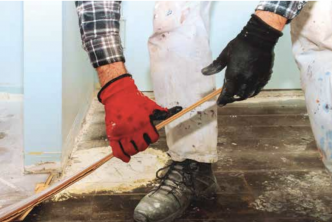by Kendra Budd, Associate Editor
The majority of claims against restoration contractors are settled quietly—but every once in a while, a case can go public in a big way. One such case is Comey v. State Farm et al.
The Comeys, a married couple, sued State Farm, along with both of the restoration contractors (RCs) who did work for them: SERVPRO and Service Master, adding the Service Master franchisor to the suit for good measure.
While the case was litigated and resolved in 2016, it provides a rare inside look into the types of allegations that RCs face in a lawsuit and provides some teachable lessons for how to protect your firm against similar lawsuits. It is one of those “classic” lawsuits that proves a great case study for anyone that’s concerned with risk management in this industry.
At the time, the case went viral all over local and state media in California. The specter of a family being forced from their home because of (alleged) unaddressed water damage, toxic mold growth, and other environmental hazards is the perfect narrative for the media to run with!
Here’s how it happened and what we can learn from it.
A Simple Water Leak
Cindy and Greg Comey, along with their two children, were living in Mission Viejo, California when their home suffered a “sudden and accidental water loss” which started upstairs and quickly traveled through the ceiling to the downstairs and then into the crawl space. The water damage was so extensive that the house was deemed uninhabitable. The Comeys fled their house as quickly as possible and immediately contacted their insurance company, State Farm.
The Aftermath
The Comeys held a policy with State Farm for over 20 years and were part of the Premier Service Program. When they called, they were referred to SERVPRO of Mission Viejo, a vendor that was part of State Farm’s Premier Service.
State Farm made it clear to the Comeys that SERVPRO was screened and vetted. Additionally, they represented that SERVPRO would not be paid until all work was completed to the family’s satisfaction and services came with a five-year warranty.
The Comeys first complaint was the fact that SERVPRO did not arrive until the next day following the water loss.“Immediate and thorough emergency dry out was necessary to prevent mold growth and to mitigate further water damage to [the] home. Mold can grow within a 24-hour period,” the suit alleges.
Arriving the day after the water loss, SERVPRO began dry out services and within a couple of days, SERVPRO reported that the home was dry and the Comeys could return. But within two weeks, the family started smelling mold in the home.
The Comeys allege that SERVPRO had originally promised to perform mold testing, but no mold testing was ever completed—so the family was forced to pay for their own out of pocket. In an interview with ABC 7, Cindy said, “When we found out the results, it was a shock. The house was contaminated with mold.” The family moved into a hotel, but by then State Farm had already paid SERVPRO, despite the family’s dissatisfaction with the services provided.
Unhappy with the work of the initial restoration contractor (SERVPRO), the Comeys insisted that State Farm bring in a different dry out and mold remediation vendor. Through State Farm’s Premier Service Program, a local ServiceMaster franchise was recommended and hired.
However, it would be more than 60 days from the initial water leak until Service Masters Complete Restoration (ServiceMaster) arrived at the property to “address the still wet building materials and mold contamination.”
After ServiceMaster completed their work, the Comeys argued that they had simply concealed the mold, instead of cleaning it up.
The Lawsuit
The year after the initial water damage and two (attempted) cleanups, the Comeys filed a lawsuit against State Farm and both RCs for breach of contract, breach of duty of good faith, fraud,false promise, intentional misrepresentations, and negligence. In their lawsuit they allege that the lack of taking proper channels of repairing and cleaning the damage was an attempt to cut corners and to spend as little money as possible–a fraud that State Farm and both RCs were in on. The lawsuit also argues that SERVPRO and ServiceMaster work with State Farm regularly, meaning that they are not independent from State Farm.
The lawsuit makes over a dozen allegations against SERVPRO that are classic accusations faced by RCs everywhere. Namely, that SERVPRO was negligent by:
- Placing insufficient dry out equipment in the home
- Artificially limiting the scope of work to stay within policy limits rather than advise plaintiffs of the true damage
- Failing to put up barriers to isolate wetted building materials
- Failing to demo areas of the home to allow for dry out
- Damaging the house and its contents
- Ignoring industry standards for dry out and mold prevention
- Covering up mold contamination
- And much more!
The Comeys alleged that ServiceMaster committed the exact same 15 errors and omissions as SERVPRO did.
According to the Comeys, the upstairs bathtub was where the water leak originally began. However, neither SERVPRO or Service Master took out the bathtub, where water was trapped under it since the first incident. Service Master then allegedly sprayed Kilz’s white paint on the mold spots, in an attempt to cover it just to pass a second mold test. They charged the Comey’s just under $5,000 for remediation. “That’s how they save money—by cutting corners,” said Evangeline Grossman, the Comeys’ attorney.
Conspiracy
The Comeys advanced another argument that will be familiar to any RC: that the insurance company was “in cahoots” with the contracting companies to pay as little as possible. Grossman argued that the whole reason behind State Farm’s actions, including having SERVPRO and Service Master as their preferred vendors, was a ploy to spend as little money as possible. “Defendants, and each of them made the misrepresentation with the intention of inducing plaintiff’s reliance, so that plaintiffs would hire a service provider who would under scope the loss and conceal damage rather than a legitimate contractor who would properly scope the loss and perform all work necessary to remediate the water and mold damage,” Court documents state.
In emails recovered by their attorney, Evangeline Grossman, during the litigation process, a veteran State Farm claims team manager wrote to his adjuster: “We can say all we want that they are independent contractors, but I think we would lose in court,” reported ABC7.
Rebuttal
State Farm’s opening paragraph sums up the defendants’ rebuttal nicely: “Plaintiffs sued us because of some generalized dissatisfaction with their water loss claim…[but] fail to allege any specific facts to demonstrate how the contract was breached or which policy provision was violated so as to constitute breach of contract. Instead plaintiffs rely on boilerplate allegations of unreasonable claim handling without stating any facts to support these allegations.”
The legal briefs filed by State Farm, SERVPRO, and Service Master all consistently attack the glaring lack of details and facts included in the Comeys’ lawsuit. All argued that the Comeys’ lawsuit, while including the classic accusations that you would see against a restoration contractor, lacked sufficient detail to even proceed on a legal basis.
Lessons Learned
While the public nature of this dispute was most unfortunate for all involved, the Comeys eventually reached an undisclosed settlement with State Farm and the suits against SERVPRO and ServiceMaster were dismissed. This, of course, happened right before the case went to trial.
Kari Dybdahl, the President of ARMR, the lead underwriter for OREP’s remediation and restoration contractor insurance suite, says that the claims made by the Comeys in this case are very classic allegations seen by many restoration contractors nationwide.
In terms of what lessons we can learn from it, Dybdahl says there are five main things you should be doing to avoid claims and complaints:
- Follow the standards.
- Stay in touch with the customer.
- Create a detailed work file for every job, including why you did what you did, and so on.
- Try not to work for bad customers.
It all starts with the standards, according to Dybdahl. “Every word in the Institute of Inspection Cleaning and Restoration Certification (IICRC) has been reviewed from a risk management standpoint, so sticking to the industry standards and guidelines is job number one. Our standards are peer reviewed by thousands of people and you don’t want to be doing anything outside of that,” says Dybdahl.
Next, you want to be very careful not to lose contact with the customer. “A very common reason for claims is the property owner gets disappointed with the quality of workmanship. Maybe you put in the wrong color floor or fail to stay in communication with the customer. Often a petty dispute will devolve into something more. The RC will say ‘I’m not going to fix your floor because you owe me money,’ or ‘I’m not going to give you your furniture back unless you pay me.’ A petty dispute can easily turn into something really ugly because a lawyer really can’t make much money on that matter unless they can come up with additional damages,” reports Dybdahl.
That’s why it’s very important to pay attention to your quality control. “We see very large restoration firms that have never been sued and then we see smaller $500,000 per year firms that have three losses a year. The difference can be stark in terms of how the business is run. We just saw a claim where the restoration firm had really ignored that homeowner for 8 months. Larger firms have jobs that don’t turn out so well, but they resolve them without getting sued. The quicker you catch an issue, the less expensive it is going to be. And don’t let the job drag on; get in there and get out. Frequent check-ins with the customer, good quality control, and a willingness to make it right with the customer goes a long way,” argues Dybdahl.
Third, note your file as if you were to be deposed. “Make sure your notes are detailed and document as much as you can. Imagine if you were to be deposed and you’re looking back at your notes from two years ago. You don’t want to leave much ambiguity as to why you did what you did. Maybe you had a good reason why you did something. However, you’ll have to explain why you did what you did if you ever wind up in court,” Dybdahl says.
Next, try not to work for bad customers. This is, admittedly, easier said than done. “If you’re thinking you’re talking to someone you don’t want to be working with, you should try not to work with them. This is hard to do if you’re on a repair network, but there is sometimes nothing you can do to overcome the downstroke of a bad customer. If you have a customer that is deadset on being dissatisfied and blaming you, it might not matter how well you communicate or how good a job you do, it won’t stop them from filing a suit. In those cases, you’ll need to rely on the fact that you followed the standards and took good notes,” reports Dybdahl.
Lastly, make sure you have the right insurance coverage for the work that you’re doing. Based on Dybdahl’s policy audits of over 1,000 restoration firms’ insurance policies, 60% of firms are
not properly covered. “The majority of General Liability policies being carried by RCs in the market today exclude Category 3 water losses. This means in cases like this one, where the water was sitting for a day before the restoration firm arrived, technically that would be excluded under most GL policies.”
The problem is that many of the insurance brokers who help restoration firms find coverage are not educated on the unique risks faced in the industry.
Restoration firms that are looking for a single policy that is specifically designed for their restoration and remediation business can visit OREP.org. OREP specializes in restoration contractor insurance and offers comprehensive policies specifically designed for the unique risks faced by RCs. Visit OREP.org/RR to learn more.
Stay safe out there!





